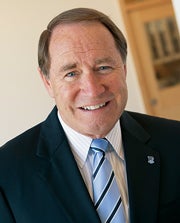President’s View

URI—like the rest of the world—has become an increasingly 24/7 environment, connected to a global community of scholars.
Although commencement is long past, URI’s campuses were far from dormant over the summer. Just as J Term keeps our under-graduates engaged throughout winter break, the summer months find both undergraduates and graduates working alongside faculty mentors in labs, aboard research vessels, in the field, and on archaeological digs. The University never completely sleeps.
My job keeps me busy throughout the year and across the world, because building a globally engaged university is a key priority. A recent trip to Indonesia is captured in this photo. The first URI delegation to Indonesia, including Deans John Kirby and Paul Larrat, was rewarding on many levels. It’s clear that our University is more of an international hub than it has ever been. In the past six years we have signed 45 new partnerships and agreements with 33 international institutions, from China to Chile, and from Denmark to Spain. We educate students from 15 countries. And they educate us.
Our strategic goal of internationalizing and globalizing the University—which broadens our cultural horizons and enriches our campus as well as our home state—is shared by other public research institutions. According to a recent report of the American Academy of Arts & Sciences, “Public Research Universities: Why They Matter”: “In an interconnected and rapidly changing world, the United States requires an educated citizenry to support a constant flow of research and innovation and to sustain its international competitiveness. Public research universities are a foundational piece of the U.S. educational infrastructure that meets this need.”
This concise report details how public institutions serve the national interest, contribute to the innovation economy, provide quality educational opportunities at an efficient cost, improve access and affordability for underserved populations, and practice responsible spending. It is timely and engaging reading, replete with concrete examples of the value of public institutions, where nearly 75 percent of college students in the U.S. study.

In the coming year, I plan to share thoughts in these pages on how our University can fulfill its roles and responsibilities as an international public research institution. Like other universities, we are faced with the substantial, multiple challenges of declining federal support for research, the need to rebuild state support for higher education, and increasing enrollments. But we also embrace tremendous opportunities to collaborate with local, national, and international partners. This issue’s story on the INBRE network, which has brought $61 million in research dollars to Rhode Island since 2001, is a perfect illustration of just this kind of collaboration. From our recent designation as a top pharmacy school in residency program placements to the cranes across our campus demonstrating our investment in state-of-the-art facilities, we have many reasons to look ahead with pride and optimism.
And on that hopeful note, we welcome the Class of 2019.
I look forward to our continued conversation.
David M. Dooley
 Home
Home Browse
Browse Close
Close Events
Events Maps
Maps Email
Email Brightspace
Brightspace eCampus
eCampus


